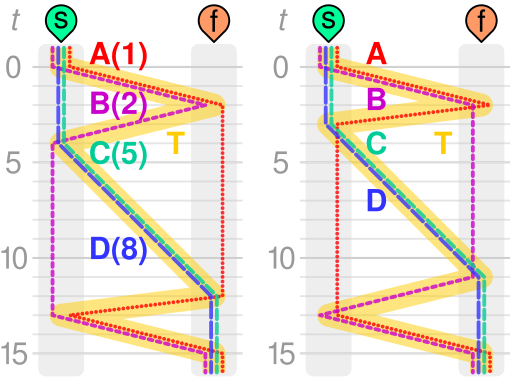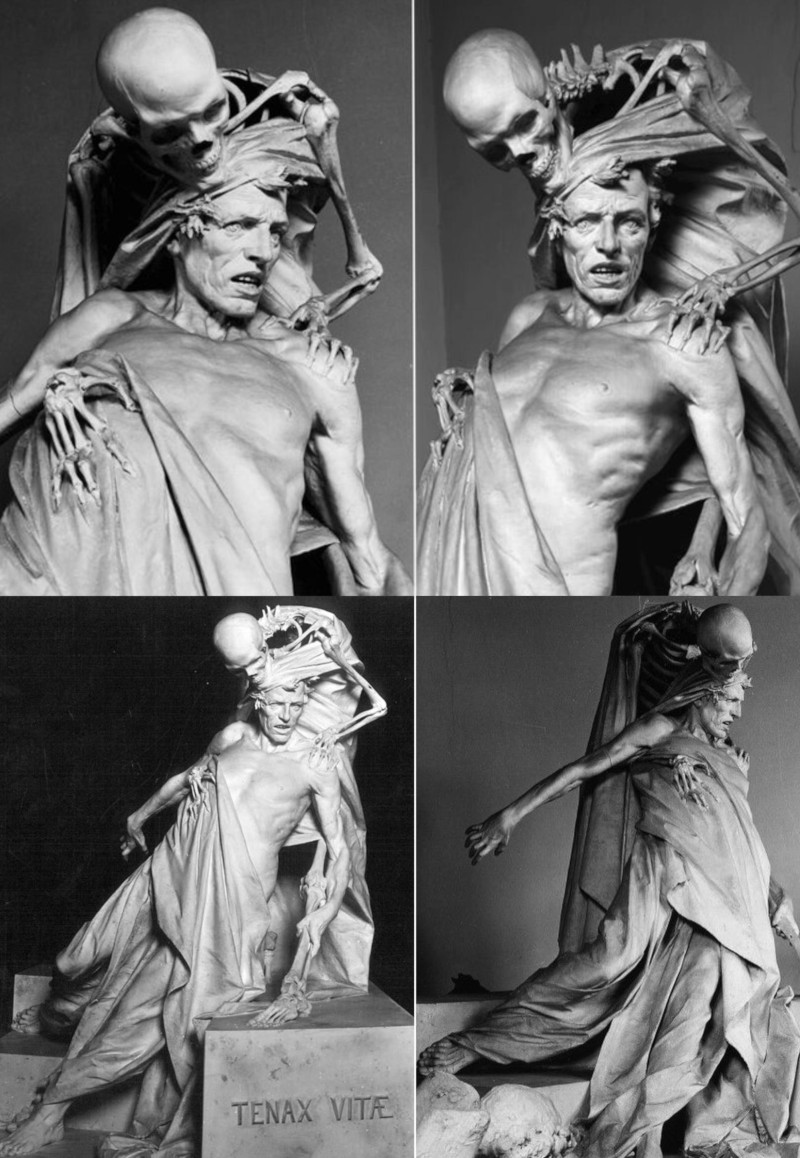Four people are traveling in the dark when they arrive at a river. The narrow bridge can accommodate only two people at a time, and the group has only one torch, which must accompany each party that makes a crossing. Persons A, B, C, and D can cross in 1, 2, 5, and 8 minutes, respectively, and any pair of travelers can move only at the pace of the slower person. The torch will go out in 15 minutes. Can they all get safely across?
Author: Greg Ross
The Unknotting Problem
The least knotted of all knots is a simple closed loop, the “unknot.” Certainly this is easy to spot on its own, but adding even a few twists can make it hard to recognize:
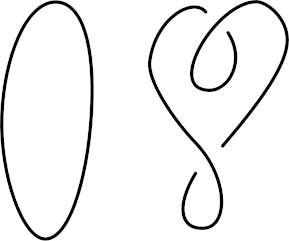
An elaborately draped loop can be quite difficult to distinguish from a knottier knot. Is this an unknot?
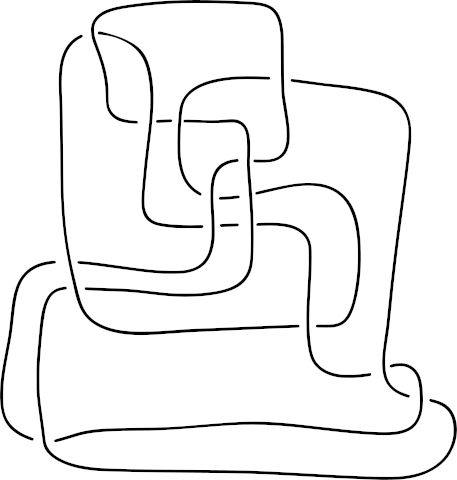
(Yes, it is.)
Surprisingly, while research is ongoing, it remains unknown whether the challenge of recognizing unknots is efficiently solvable — whether an algorithm can accomplish the task in polynomial time. It’s an open question.
The Bristol Bridges Walk
In the 18th century Leonhard Euler famously addressed the question whether it was possible to walk through the city of Königsberg and return to one’s home having crossed each of seven bridges exactly once.
The answer, briefly, was no, but in 2013 network scientist Thilo Gross noticed that the city of Bristol has a similar layout, and here the task is possible: If you’re willing to walk 30 miles, you can cross each of the 45 bridges on this map and return to your starting point.
Companion
Rinaldo Carnielo’s sculpture Tenax Vitae stands in the Galleria Rinaldo Carnielo in Florence.
After meeting the sculptor in 1893, Helen Zimmern observed that “for him, the shadow of death pervades all existence,” but “he cares not one jot whether his statues find purchasers so long as he himself is satisfied with the results.”
Hard to Say
A paradox by Columbia University logician Haim Gaifman:
line 1: The sentence on line 1 is not true.
line 2: The sentence on line 1 is not true.
line 3: The sentence on line 2 is not true.
line 4: The sentence on line 3 is not true.
line n + 1: The sentence on line n is not true.
All these sentence are equivalent, because each essentially restates its predecessor. Since the sentence on line 1 isn’t true, the sentence on line 3 isn’t true either. “[B]ut what I have just stated is not true, because it is the sentence on line 4 (or an obviously equivalent reformulation of it), and also this last statement of mine is not true, because it is the sentence on line 5, etc. None of these sentences can be successfully asserted, because none of them is true; but again I find myself slipping into nontruth: what I have just said is not true for it obviously includes the conjunction of these very same sentences; and also this last assertion is not true, and so on ad infinitum.”
(Haim Gaifman, “Pointers to Truth,” Journal of Philosophy 89:5 [May 1992], 223-261. See Yablo’s Paradox.)
The Most Wonderful Time of the Year
In the middle of winter when fogs and rains most abound they have a great festival which they call Exmas and for fifty days they prepare for it in the fashion I shall describe. First of all, every citizen is obliged to send to each of his friends and relations a square piece of hard paper stamped with a picture, which in their speech is called an Exmas-card. But the pictures represent birds sitting on branches, or trees with a dark green prickly leaf, or else men in such garments as the Niatirbians believe that their ancestors wore two hundred years ago riding in coaches such as their ancestors used, or houses with snow on their roofs. And the Niatirbians are unwilling to say what these pictures have to do with the festival; guarding (as I suppose) some sacred mystery. And because all men must send these cards the marketplace is filled with the crowd of those buying them, so that there is great labour and weariness.
But having bought as many as they suppose to be sufficient, they return to their houses and find there the like cards which others have sent to them. And when they find cards from any to whom they also have sent cards, they throw them away and give thanks to the gods that this labour at least is over for another year. But when they find cards from any to whom they have not sent, then they beat their breasts and wail and utter curses against the sender; and, having sufficiently lamented their misfortune, they put on their boots again and go out into the fog and rain and buy a card for him also. And let this account suffice about Exmas-cards.
— C.S. Lewis, “Xmas and Christmas: A Lost Chapter From Herodotus,” Time and Tide, Dec. 4, 1955
Tableau
A pleasing little detail: In Arthur C. Clarke’s 1946 story “Rescue Party,” a federation of aliens visit Earth immediately before the sun explodes, hoping to rescue its inhabitants. To their surprise, they don’t find us (it turns out we’ve fled the planet), and they comb our deserted civilization.
The explorers were particularly puzzled by one room — clearly an office of some kind — that appeared to have been completely wrecked. The floor was littered with papers, the furniture had been smashed, and smoke was pouring through the broken windows from the fires outside.
T’sinadree was rather alarmed.
‘Surely no dangerous animal could have got into a place like this!’ he exclaimed, fingering his paralyzer nervously.
Alarkane did not answer. He began to make that annoying sound which his race called ‘laughter.’ It was several minutes before he would explain what had amused him.
‘I don’t think any animal has done it,’ he said. ‘In fact, the explanation is very simple. Suppose you had been working all your life in this room, dealing with endless papers, year after year. And suddenly, you are told that you will never see it again, that your work is finished, and that you can leave it forever. More than that — no one will come after you. Everything is finished. How would you make your exit, T’sinadree?’
The other thought for a moment.
‘Well, I suppose I’d just tidy things up and leave. That’s what seems to have happened in all the other rooms.’
Alarkane laughed again.
‘I’m quite sure you would. But some individuals have a different psychology. I think I should have liked the creature that used this room.’
No explanation is given. “His two colleagues puzzled over his words for quite a while before they gave it up.”
Operation Cornflakes

To disrupt German morale during World War II, the Allies hatched a plan to send anti-Nazi propaganda to German citizens through the mail. They quizzed prisoners of war about the German postal service and drew on local telephone directories to identify 2 million addressees who might receive forged letters and subversive material. Then the letters were loaded into counterfeit mailbags and dropped near destroyed trains in the hope that they’d be collected and delivered.
By 1945 twenty missions had been completed, but by then many German homes had been destroyed and their inhabitants killed or displaced, so the operation had limited effect. Above is a striking stamp prepared for the effort — the subscript on the “death head” stamp reads “Futsches Reich” (ruined empire) rather than “Deutsches Reich” (German Empire). Altogether 96,000 stamps were prepared for the effort, but the “death head” stamp may never have been used.
Words and Pictures
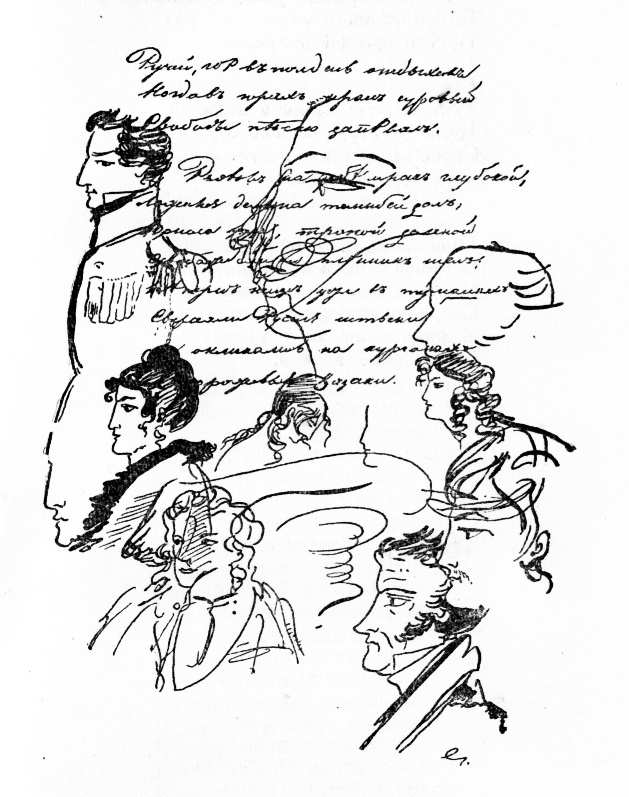
This just caught my eye: In his manuscripts and notebooks, Alexander Pushkin often sketched the characters he was describing, as well as friends, family, romantic partners, and other literary figures. One biographer calls the drawings Pushkin’s graphic diary. This page is from his 1822 poem The Prisoner of the Caucasus.
The Heist
A puzzle by Jared Z., Nicole H., and Benjamin E., mathematicians at the National Security Agency:
The chief detective hurried down to the police station after hearing big news: there was a heist at Pi National Bank! The police had brought in seven known gang members seen leaving the scene of the crime. They belonged to the nefarious True/False Gang, so named because each member is either required to always tell the truth or required to always lie, although everyone is capable of engaging in wrongdoing. The chief also knew from his past cases that any crime committed by the gang always included one truth teller.
When the chief showed up, he asked the gang members the following questions:
1) Are you guilty?
2) How many of the seven of you are guilty?
3) How many of the seven of you tell the truth?
Here were their responses:
Person 1: Yes; 1; 1
Person 2: Yes; 3; 3
Person 3: No; 2; 2
Person 4: No; 4; 1
Person 5: No; 3; 3
Person 6: No; 3; 3
Person 7: Yes; 2; 2
After looking these answers over, the chief prepared to arrest those responsible.
Which of these seven did the chief arrest?

